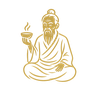Manifesto of the Path of Wisdom
“The Invisible Civilization: Where Knowledge Came From”
A true civilization does not leave behind concrete towers. It leaves breath, stillness, and clarity in the heart of the seeker.
Introduction
For thousands of years, humanity has lived among the ruins of a great past. Not of machines and towers, but of structural knowledge—about the body, the mind, and the laws of existence. Integrated systems: from yoga and Taoist alchemy to Chinese medicine and breathwork. Where did they come from?
This is not folklore, nor random intuition, nor magic. These are remnants of a civilization whose vector of development was inward, not outward. They didn’t build rockets. They built the human being.
1. Why They Are Invisible
There are almost no material traces left. But what remains includes:
- systems of knowledge deeper than modern medicine;
- rituals that shape the personality;
- breathing methods that alter physiology and consciousness;
- and most importantly — structure: levels, principles, hierarchy, methodology.
Such systems could not arise amidst barbarism, short life spans, nomadic existence, constant war, or illiteracy. They require stability, independence, enlightenment — a culture where the human being is the center of civilization.
2. Technologies of a Different Kind
This forgotten civilization did not develop engines. It developed attention.
Its science was inner observation. Its microscope — meditation. Its laboratory — the body and breath.
It knew:
- how to direct inner energy;
- how to heal without intrusion;
- how to preserve memory not in books, but in the bodies of students;
- how to transmit knowledge without distortion — through ritual, embodied transmission, and symbols.
This was a civilization of wisdom — not of technology.
3. The Flood and the Break
Myths in every culture speak of a flood, a fall, a separation, a scattering.
What was once whole began to fracture: schools were closed, masters killed, knowledge lost or distorted.
But fragments remained, scattered across the world:
- in the hymns of the Vedas;
- in Taoist breath practices;
- in Tibetan yantras;
- in shamanic circles;
- in Sufi dhikr rituals;
- in remnants of folk medicine.
All of them — shards of a single, vanished body. A civilization where the conscious human was the center of the universe.
4. What Remains, and What Must Be Restored
Modern civilization is preoccupied with the outer world. But within — there is emptiness.
The world calls us back to a knowledge that requires no machines — only clarity, discipline, and a direct path.
Yoga, Qigong, breathwork, meditation, pulse reading, energy, shen, dantian — these are not esoterica. They are the remnants of inner engineering.
5. The Path of Wisdom as a Return
The Path of Wisdom is not a new religion, invention, or cult.
It is an attempt to restore the lost core of human civilization — where:
- development moved from within outward,
- technology began with spirit, not steel,
- and knowledge was not sold, but cultivated like a garden.
The true path is not progress forward, but return to the Source.
Humanity did not lose wisdom. It turned away from it.
Core Principles of the Path of Wisdom:
- The human being is the primary tool of understanding.
- Attention is the core instrument.
- Consciousness and the body are the field of practice.
- Knowledge is not written — it is transmitted.
- True progress is inner evolution.
- Technology is an extension of spirit, not a replacement for it.
- The goal is not control, but clarity.
- A true civilization liberates the individual — it does not enslave them.
Conclusion
The Path of Wisdom is not something to be invented — it is something to be restored.
We do not need to reinvent meaning. We must clear the path to it.
Wisdom is not just knowledge.
Wisdom is a way of living in knowledge — of being its continuation.
Of being oneself: clear, awakened, and free.

